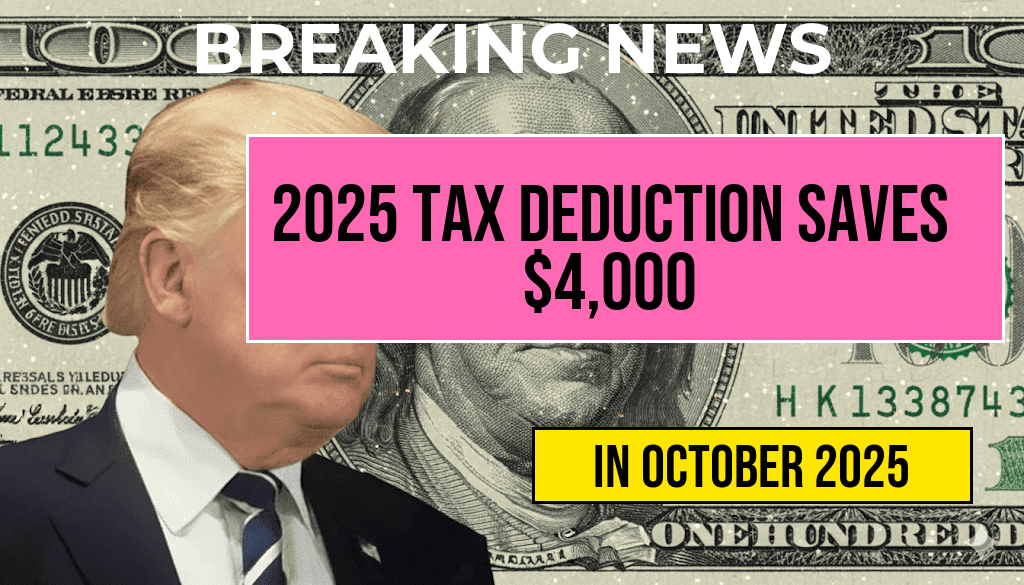A new federal tax provision set to take effect in 2025 promises significant savings for low-income individuals and seniors, offering up to $4,000 in tax deductions. The updated policy aims to reduce financial burdens for vulnerable populations by expanding eligibility and increasing deduction limits. According to the Internal Revenue Service (IRS), this initiative is part of broader efforts to promote economic stability among Americans facing financial challenges. Eligible taxpayers, particularly those with limited income or fixed retirement income, could see substantial reductions in their tax bills, potentially enhancing their overall financial security. The measure reflects ongoing legislative priorities to support marginalized communities and address income inequality. As the new rules roll out, financial advisors and community advocates emphasize the importance of understanding eligibility criteria and documentation requirements to maximize benefits. Detailed guidance from the IRS and updates on implementation timelines are expected to help millions of Americans take full advantage of the upcoming tax relief.
Understanding the 2025 Tax Deduction Expansion
Who Qualifies for the New Deduction?
- Low-Income Individuals: Taxpayers earning below 200% of the federal poverty line qualify for the benefit. This includes many working adults and families with limited resources.
- Seniors: Individuals aged 65 and older, especially those relying on fixed incomes such as Social Security or retirement savings, are primary targets of the expanded deduction.
- Disability Recipients: Those receiving disability benefits also stand to benefit, as the deduction aims to assist individuals with increased healthcare and living expenses.
How Much Can Be Saved?
| Eligibility Group | Maximum Deduction | Estimated Tax Savings |
|---|---|---|
| Low-Income Individuals | $4,000 | $800–$1,200 |
| Seniors (Over 65) | $4,000 | $800–$1,200 |
| Disability Recipients | $4,000 | $800–$1,200 |
Legislative Background and Implementation
The new deduction derives from recent amendments to the Taxpayer Relief Act of 2024, which Congress passed earlier this year. The legislation aims to bolster support for economically vulnerable groups by increasing the maximum deductible amount and broadening eligibility thresholds. The IRS has announced that eligible taxpayers will be able to claim the deduction starting with the 2025 tax year, with detailed instructions forthcoming via its official website (irs.gov). The agency is also expected to provide additional guidance on required documentation and filing procedures, ensuring that taxpayers can navigate the changes effectively.
Impact on Tax Filing and Financial Planning
Tax professionals highlight that the expanded deduction could significantly lower tax liabilities for millions of Americans. For low-income workers and seniors, the increased deduction limits may mean the difference between owing taxes and receiving refunds. Financial advisors recommend reviewing eligibility early in the year and maintaining thorough records of income and expenses. Moreover, this policy could influence broader financial planning strategies, including retirement savings and healthcare budgeting, especially for those on fixed incomes.
Community and Advocacy Responses
Multiple advocacy groups have welcomed the expansion, emphasizing its potential to alleviate financial stress among vulnerable populations. “This new deduction represents a meaningful step toward making tax policy more equitable,” said Maria Lopez, director of the National Low-Income Taxpayer Coalition. “We urge eligible individuals to seek assistance from community organizations or tax professionals to ensure they maximize their benefits.”
However, some critics caution that awareness remains a challenge. “Many eligible taxpayers may not be aware of these changes,” noted Robert Chen, senior policy analyst at the Institute for Fiscal Studies. “Efforts to disseminate information effectively will be crucial in ensuring the policy’s success.”
Additional Resources and Next Steps
- IRS Official Guidance: irs.gov/newsroom/2025-tax-deduction-expansion
- Community Assistance Programs: Contact local tax clinics or social service agencies for free filing support.
- Further Reading: Learn more about federal income thresholds and tax credits at Wikipedia’s Taxation in the United States.
Frequently Asked Questions
What is the new 2025 tax deduction for low-income individuals and seniors?
The 2025 tax deduction offers eligible low-income individuals and seniors the opportunity to save up to $4,000 on their taxes, aimed at providing financial relief and support.
Who qualifies for the 2025 tax deduction?
Eligible qualifiers include low-income individuals and seniors who meet specific income thresholds and other criteria set by the IRS for the 2025 tax year.
How can I claim the 2025 tax deduction?
To claim the deduction, taxpayers should file their taxes accurately using the appropriate forms and provide necessary documentation to prove eligibility. Consulting a tax professional is recommended for detailed guidance.
Are there any income limits or restrictions for this deduction?
Yes, the deduction has income limits to ensure it benefits low-income individuals and seniors. Specific thresholds are outlined by the IRS and may vary based on filing status and other factors.
When does the 2025 tax deduction take effect?
The deduction is available for tax filings in 2025, covering income earned during the 2025 tax year, with details and eligibility criteria announced by the IRS ahead of the tax season.






